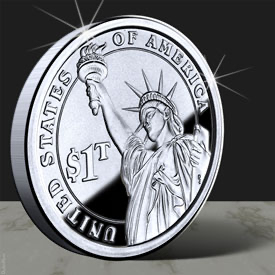Federal Reserve rate hikes meant to quell inflation may ultimately have the opposite effect.
Of course, higher borrowing costs will force consumers to scale back and businesses to trim payrolls. A contraction in debt-financed economic activity will in theory cause inflation to fall.
However, contrary to popular misconceptions perpetuated by the Fed, the root causes of inflation aren't tied to employment or economic growth. Inflation occurs when the currency supply expands too rapidly as confidence in the ability of U.S. dollars to retain their value falls.
Higher interest rates may well induce a recession that temporarily causes demand for money and credit in the private sector to contract.
Meanwhile, such conditions wouldn't blunt government demand for new currency. Quite the opposite!
During recessions, the government tends to increase spending on "stimulus" programs even as revenues shrink.
Members of Congress, unlike heads of households or CEOs of corporations, don't practice austerity when times are tough or borrowing costs go up. They keep spending and borrowing.
Up until recently, politicians had the luxury of being able to finance their fiscal profligacy at ultra-low rates. But now their deficit spending will carry a massive cost increase in terms of interest owed.
Within just five years, annual interest on the national debt will surpass what the United States spends on national defense. The Congressional Budget Office projects that over the next decade, the federal government will owe more than $10 trillion in interest as the principal itself (now nearly $32 trillion) continues to spiral upward.
Federal finances are trapped in a vicious circle. Uncle Sam needs to keep borrowing just to service existing debt, which creates even larger future interest obligations.
According to the Committee for a Responsible Federal Budget, "For every dollar that the U.S. government will borrow over the next decade, 50 cents will be just to pay interest on our national debt."
Rate hikes represent a Catch-22 for Fed policymakers. If they stop hiking while inflation continues to run above target, they may never be able to get out in front it. But if they keep hiking, they will induce the U.S. Treasury Department to extend its lines of credit – which is inflationary.
Some members of Congress are putting their foot down on deficit spending – or at least making a show of it – and vowing not to raise the statutory debt ceiling without at least some budget concessions from the Biden administration.
Biden officials are refusing calls for spending cuts and eying possible work-arounds to bypass Congress completely.
Among the possibilities, originally floated by Obama administration operatives, would be to have the Treasury Department mint a platinum coin with an arbitrary $1 trillion face value, sell it to the Federal Reserve, and use the cash to pay the government's bills.

"The Trillon Dollar Coin"
By DonkeyHotey - Flickr, CC BY 2.0, Wikipedia
Such a move would not only be a massive administrative power grab; it would also be an inflection point toward a "print on demand" monetary system that does away with the formalities of getting financing through the bond market.
In February, Senator Mike Lee (R-UT) introduced the Cancel the Coin Act to block the Biden administration from attempting to concoct trillions of dollars out of thin air.
According to Lee, "The Cancel the Coin Act removes a legal loophole that allows the Treasury Secretary to bypass the statutory borrowing limit by minting platinum coins of any denomination."
He added, "A modern monetary theory-inspired spending spree would be disastrous for the American economy and the American way of life."
Treasury Secretary Janet Yellen is reluctant to employ a scheme that would signal so bluntly to the world that the United States has embarked on a course of hyperinflation as a way of managing its debt burden.
In reality however, the current system – whereby the Treasury prints bonds, the Fed prints Federal Reserve notes, and the two just swap with each other – is not fundamentally different than the Treasury just printing (or minting) intrinsically worthless money by itself.
However the debt ceiling fight gets resolved politically, there will be no resolution to the underlying debt problem.
Officials may be able to stave off a full-blown financial disaster this time around, but they won't be able to get federal finances off their unsustainable fiscal path.
If a Zimbabwe-style hyperinflation sets in, then platinum may someday be worth $1 trillion (or more) per ounce. While such a scenario cannot be ruled out, the years immediately ahead may be more akin to the late 1970s when rising interest rates and rising inflation gave rise to an epic precious metals bull market in both nominal and real terms.
Platinum – along with gold, silver, and other hard assets – are cheap today relative to the prices they could command in the future as the government accumulates more obligations by the trillions.

